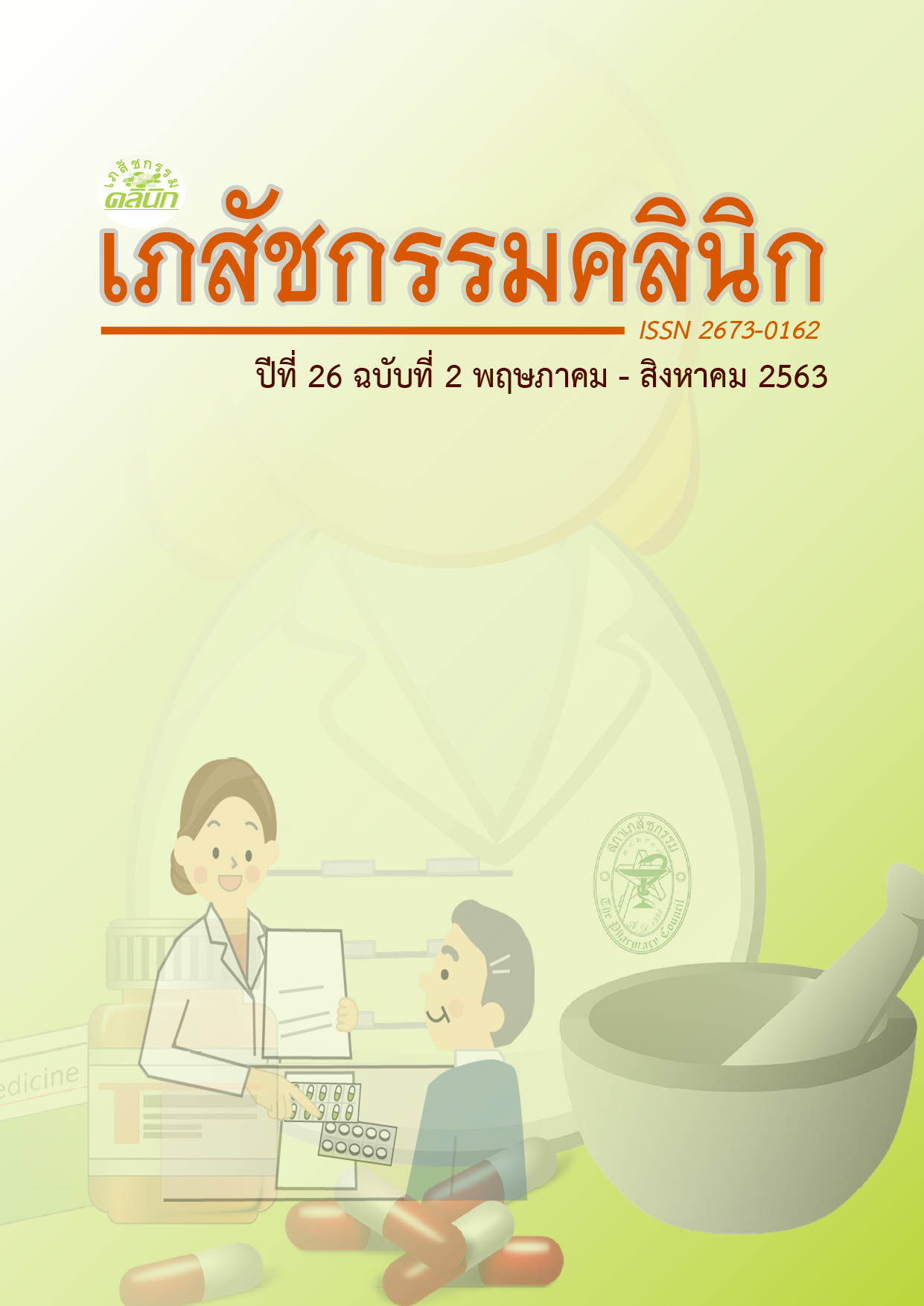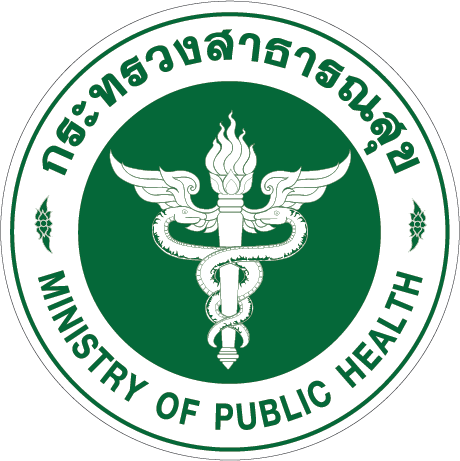Review of omeprazole prescribing in Angthong hospital
Keywords:
omeprazole, inappropriate prescribing, drug reviewingAbstract
This study aimed to review drug prescribing for outpatients and studied about inappropriate omeprazole prescribing. The treatment data were collected from the electronic databases retrospectively from October 2019 to September 2020. Appropriate prescribing was defined as receiving omeprazole with the approved indication from United States Food and Drug Administration (US-FDA) or Thai FDA.
The results revealed that outpatients received omeprazole 20,692 visits in 8,151 patients. Average age of patients was 55.8 ± 18.3 years. A total of omeprazole prescribing with approved indication was 1,310 visits (6.3%). The indication of gastro-oesophageal reflux disease without oesophagitis were the most prescribed of 73.4%. Moreover, inappropriate prescribing was 19,382 visits (93.7%) with financial loss of 1,968,602 baht. According to the individual review of inappropriate prescribing in 399 patients, the drug was administered continuously for a period of 1 - 5 years (21.3%). The most reason for prescribing was using to treat abnormal condition with unapproved indication for a 7-15 days period (26.1%) and using omeprazole with NSAIDs (22.3%), respectively.
In conclusion, the most indication of omeprazole prescribing for outpatients in the hospital was inappropriate which may cause side effects from drug uses and financial loss in the future. Therefore, policy or guideline for appropriate omeprazole prescribing should be taken by multidisciplinary via the pharmacy and therapeutic committee (PTC).
References
Reid M, Keniston A, Heller JC, Miller M, Medvedev S, Albert R. Inappropriate prescribing of proton pump inhibitors in hospitalized patients. Journal of hospital medicine 2012;7: 421-425.
ภาวิตา จริยาเวช, ปิยะเมธ ดิลกธรสกุล. การใช้ยาโอเมพราโซลเกินความจำเป็นและความสูญเสียทางการเงินในบริบทโรงพยาบาลชุมชน. TJPP 2562;10: 437-448.
Durand C, Willett KC, Desilets AR. Proton pump inhibitor use in hospitalized patients: is overutilization becoming a problem?.Clinical Medicine Insights: Gastroenterology 2012;5: CGast-S9588.
คณะกรรมการผู้จัดทำแนวทางเวชปฏิบัติการดูแลรักษาผู้ป่วยโรคกรดไหลย้อนในประเทศไทย. แนวทางเวชปฏิบัติการดูแลรักษาผู้ป่วยโรคกรดไหลย้อนในประเทศไทย พ.ศ. 2563 (Thailand GERD guideline 2020). กรุงเทพฯ:สมาคมประสาททางเดินอาหารและการเคลื่อนไหว;2563.
World Health Organization.Classification of Diseases (ICD). Available at: https://icd.who.int/browse10/2019/en. Accessed October 12,2020.
U.S. Food and Drug Administration. Drugs@FDA: FDA-Approved Drugs Available at: https://www.accessdata.fda.gov/scripts/cder/daf/ Accessed October 20,2020.
สำนักงานคณะกรรมการอาหารและยา. ตรวจสอบการอนุญาต. สืบค้นจาก: https://porta.fda.moph.go.th/FDA_SEARCH_ALL/MAIN/SEARCH_CENTER_MAIN.aspx วันที่เข้าไปสืบค้น 20 ตุลาคม,2563.
Yamane T. Elementary sampling theory. 1967.
พิณประไพ เกื้อกูล. การประเมินการใช้ยาโอเมพราโซลในโรงพยาบาลคลองหลวง. GPO 2563; 46: 17-22.
ศุภทัต ชุมนุมวัฒน์. Issue of Proton Pump Inhibitors Use in the Elderly. ใน: บุษบา จินดาวิจักษณ์ และธนรัตน์ สรวลเสน่ห์. บรรณาธิการ. บทบาทของเภสัชกรโรงพยาบาลในการใช้ยาอย่างสมเหตุผล. 1. กรุงเทพฯ: บริษัทประชาชนจำกัด, 2559: 157-163.
Abraham NS, Hlatky MA, Antman EM. et.al. ACCF/ACG/AHA 2010 Expert Consensus Document on the concomitant use of proton pump inhibitors and thienopyridines:a focused update of the ACCF/ACG/AHA 2008 expert consensus document on reducing the gastrointestinal risks of antiplatelet therapy and NSAID use: a report of the American College of Cardiology Foundation Task Force on Expert Consensus Documents. Circulation 2010; 122, 2619-2633.
Laine L. NSAID-Associated Gastrointestinal Bleeding: Assessing the Role of Concomitant Medications. Gastroenterology 2014; 147: 730–739.
Downloads
Published
How to Cite
Issue
Section
License
Copyright (c) 2022 Health Administration Division, Office of the Permanent Secretary, Ministry of Public Health and The Society of Hospital Pharmacist, Ministry of Public Health

This work is licensed under a Creative Commons Attribution-NonCommercial-NoDerivatives 4.0 International License.
ข้อความภายในบทความที่ตีพิมพ์ในวารสารเภสัชกรรมคลินิกทั้งหมด รวมถึงรูปภาพประกอบ ตาราง เป็นลิขสิทธิ์ของกองบริหารการสาธารณสุข สำนักงานปลัดกระทรวงสาธารณสุข และ ชมรมเภสัชกรโรงพยาบาลกระทรวงสาธารณสุข การนำเนื้อหา ข้อความหรือข้อคิดเห็น รูปภาพ ตาราง ของบทความไปจัดพิมพ์เผยแพร่ในรูปแบบต่าง ๆ เพื่อใช้ประโยชน์ในเชิงพาณิชย์ ต้องได้รับอนุญาตจากกองบรรณาธิการวารสารเภสัชกรรมคลินิกอย่างเป็นลายลักษณ์อักษร
กองบริหารการสาธารณสุข สำนักงานปลัดกระทรวงสาธารณสุข และ ชมรมเภสัชกรโรงพยาบาลกระทรวงสาธารณสุข อนุญาตให้สามารถนำไฟล์บทความไปใช้ประโยชน์และเผยแพร่ต่อได้ โดยอยู่ภายใต้เงื่อนไขสัญญาอนุญาตครีเอทีฟคอมมอน (Creative Commons License: CC) โดย ต้องแสดงที่มาจากวารสาร – ไม่ใช้เพื่อการค้า – ห้ามแก้ไขดัดแปลง, Attribution-NonCommercial-NoDerivatives 4.0 International (CC BY-NC-ND 4.0)
ข้อความที่ปรากฏในบทความในวารสารเป็นความคิดเห็นส่วนตัวของผู้เขียนแต่ละท่านไม่เกี่ยวข้องกับกองบริหารการสาธารณสุข สำนักงานปลัดกระทรวงสาธารณสุข และ ชมรมเภสัชกรโรงพยาบาลกระทรวงสาธารณสุข และบุคลากรในกองฯ หรือ ชมรมฯ แต่อย่างใด ความรับผิดชอบองค์ประกอบทั้งหมดของบทความแต่ละเรื่องเป็นของผู้เขียนแต่ละท่าน หากมีความผิดพลาดใด ๆ ผู้เขียนแต่ละท่านจะรับผิดชอบบทความของตนเอง ตลอดจนความรับผิดชอบด้านเนื้อหาและการตรวจร่างบทความเป็นของผู้เขียน ไม่เกี่ยวข้องกับกองบรรณาธิการ




